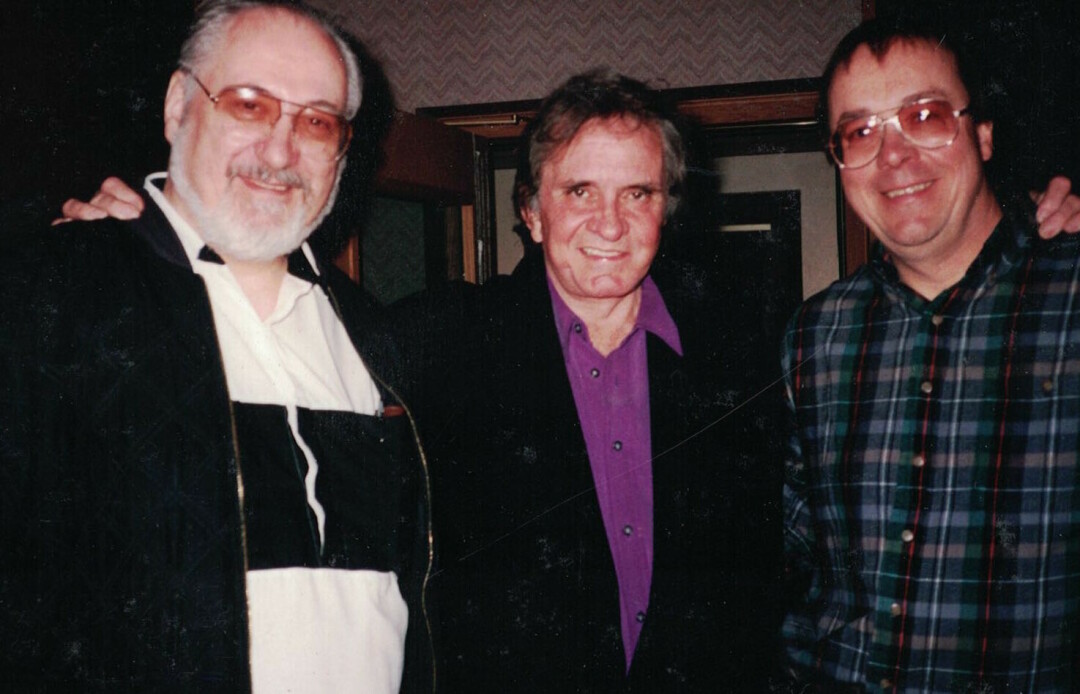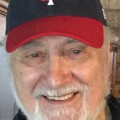Johnny Cashville

When Don asked me if I wanted to meet Johnny Cash, I knew I’d have to go, but I also had to clear it with my wife. She agreed, with the proviso that I would keep a journal while I was there. I agreed to that, and since I still have that journal, I won’t have to depend on my faulty memories for this column.
2/23/93: We took off at 3 pm, planning on driving all night, taking turns driving and napping. We took off at the start of the biggest blizzard of the year. Cars and trucks in the ditch, one semi on its side; all the rest stops were full of trucks, including the entrances and exits.
2/24: Stopped for breakfast in Bloomington, Ind. Gas was 99.9¢/gal. Still snowing in Kentucky and we first saw the sun in Louisville. It was slush in Nashville, with traffic moving at 20 mph.
Don’s older brother Keith had moved to Nashville years earlier and found some success as a songwriter. He had died, but brother Hal still lived there. We would be staying with him while we were there. Had a little breakfast with Hal and his wife Pat. Don made a call, and found that Greg would be at Georgetown Masters. Don had given me a copy of Travis Tritt’s demo tape about a year before. Greg had produced his album, and Travis was the latest sensation in Nashville.
We were met by the owner of Georgetown Masters, Denny Purcell. He spotted my very white New Balances, and sang me a verse of “New Shoes,” which was getting a lot of air play at the time. He showed us his million dollar mixing board, which was used for balancing sound and separating the tracks into left and right channels. The completed song would go to the mastering machine, which would cut the masters from which all copies would go to market.
We went downstairs, which contained a well-appointed movie theater, complete with ticket window and popcorn wagon. There were 9 big loungers from which we watched the music video of Travis’s song “T-R-O-U-B-L-E” on a big screen.
That evening we went to Diamond in the Rough, a restaurant where Jo-El Sonier was playing. He had had a hit record in “Tear-Stained Letter” and was looking for a record deal. Don’s youngest son Andy joined us there, as did Jack Purcell. Jack was from Cloquet, and had played in a band called Dakota Crossing with Greg, and Razing Cane with Billy Barnard. He was a record promoter for Warner Brothers now.
After dinner, we were introduced to Jo-el and had pictures taken. I had a chance to chat briefly with him. He remembered playing in Duluth. He was doing a show for a local radio station, so he played an hour show + encore. I enjoyed it a lot.
There were beads and Mardi Gras flags on the table, so we each got a set for souvenirs. The next day was what we came for, so we went back to Hal’s and crashed.
The next morning, we drove to SOUND STAGE Studio, where Greg and his engineer were setting up. Mark O’Connor arrived about 11 am. The song they were working on was for Mark’s Heroes album.
Charlie Daniels had a hit record called “The Devil Went Down to Georgia.” This song was a sequel to that called “The Devil Came Back to Georgia.” For this song, Charlie played the Devil’s fiddle, Travis Tritt was the voice of the Devil, Marty Stuart was Johnny, and Mark played Johnny’s fiddle parts. These tracks were completed, so the only part left was that of the Narrator, which would be taken by Cash.
Cash came in with his daughter Cindy. Cindy was impressed that we had driven all the way from Minnesota, although she wasn’t sure where Duluth was exactly.
Johnny talked about his silver wedding anniversary coming up, and the new Highwaymen tour for the spring. The Highwaymen was the supergroup consisting of Cash, Willie Nelson, Waylon Jennings and Kris Kristofferson. He said Kris was getting more political, so they were thinking of reprising the old song “The One on the Right is on the Left,” about a politically divided vocal group. He sang a couple of verses for us.
They played Mark’s song a couple of times so Cash could get a feel for it; then he went into the recording booth and did it numerous times. He was very patient, and sometimes funny.
When he came out of the booth, someone asked if we could get a few pictures. He said “Great! Let’s get LOTS of pictures.” So we did. Then he told us about the worst song he ever wrote called “Beans for Breakfast,” and sang a couple of verses.
His crib sheet was on a chair when he left, and I picked it up. Another souvenir.
Mark told us this story about Frank Sinatra and Bill Monroe. They were at the Grammys, and Frank asked to be introduced to the Father of Bluegrass Music. When they met, Frank told him how much he appreciated his music. Bill said “What was the name again?” Frank told him. “And what is it that you do?” Bill asked. Apparently, it doesn’t work both ways.
Lunch at the Cooker. Mark talked about doing a cut on Sting’s new album, and his time with The Chieftans, the Irish band that couldn’t wait to get to a pint of Guinness.
We left Greg and Mark to work on the board, drove back to Hal’s and watched the Grammys.
The next day, we toured the Country Music Hall of Fame before going to Warner Brothers to see Jack Purcell and visit with Bob Saporini, a vice oresident of Marketing and a business partner of Hal’s. He showed us the confidential promotional plan for Dwight Yoakum’s new album.
Mark reserved seating for us at the taping of The American Music Shop show he did for the Nashville Network. Songwriter Tim Mensey, Doug Stone and Mark Chesnutt were the guests.
I felt sorry for Tim, who tried to get the other two to help him on a song. They were no help. Doug Stone was a joker, and he had Chesnutt laughing so hard, he almost fell off the stage. After the show we met Paul Franklin, the pedal steel guitar player, and Brent Mason, the lead guitarist, who had done some great guitar work on Alan Jackson’s “Mercury Blues.”
At 12th and Porter, we saw Roger Miller’s son Dean, a songwriter at SONY-TREE, doing his own songs. Nothing like his father’s, but solid country. George Hamilton V looks like his father, where the resemblance ends. He started with “New Shoes.” I think Denny Purcell did it better.
Greg said the final cut of Mark’s song was on 56 tracks. It would now go to Georgetown Masters for final processing.
The next night was the Grand Ole Opry. Went in the back door. Had my picture taken with Jack Greene, a very nice man with a very bad toupee. I am surprised that someone close to him did not tell him that it looked like a bird’s nest on his head.
Billy Walker was known as the Long, Tall Texan on the Opry, although in my picture with him, I am half a head taller, and he is wearing cowboy boots. Like every Texan I have ever met, he was very soft-spoken. He had played in New York, where someone had taken him ice fishing. It was interesting he said, but he still preferred fishing from a boat. He started talking about the music business, and I think he wanted to keep chatting, but Greg and Don were moving on, so I had to leave.

Ken Johnson with Billy Walker
Backstage, I shared a glass of punch with Duane Allen, lead singer for the Oak Ridge Boys. There was a place for people to stand behind the band, so we stood there for a while. Met a girl who’s uncle was playing for Hank Snow.
Bill Monroe came in with three highly painted ladies. He was old and crabby, but stood still for a picture. Ricky Skaggs was the headliner, but I only saw his back while he talked to his wife. He was wearing a long overcoat, and left to run an errand. Kathy Mattea ran by me on her way to an interview. Much prettier in person.
On our way out of the Opry, we ran into Grandpa Jones. He had recently been at the Mayo Clinic for eye surgery, he said. Very friendly person, and the last celebrity I would see in Nashville.
